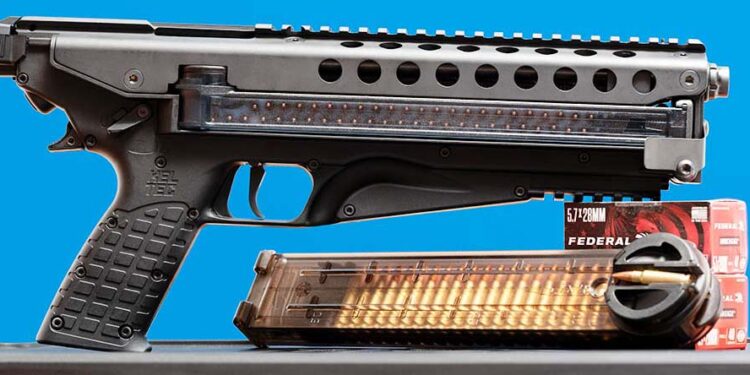By Oleg Volk –
At first glance, Kel-Tec’s new P50 pistol looks like something half-way between a drone cannon with a grip added and a submachine gun with parts missing. Designed as a shooting module, it can be adapted to different roles. For the commercial market, mainly due to the existing and the anticipated legal constraints, it was introduced in the pistol form. It’s a tax stamp away from a folding wire stock similar to a Smith & Wesson M76 or Walther MP and a vertical foregrip. The weapon brings unmanned drone guns from the movie “Alien” to mind, something with enough magazine capacity to be left unattended under automated or remote control.
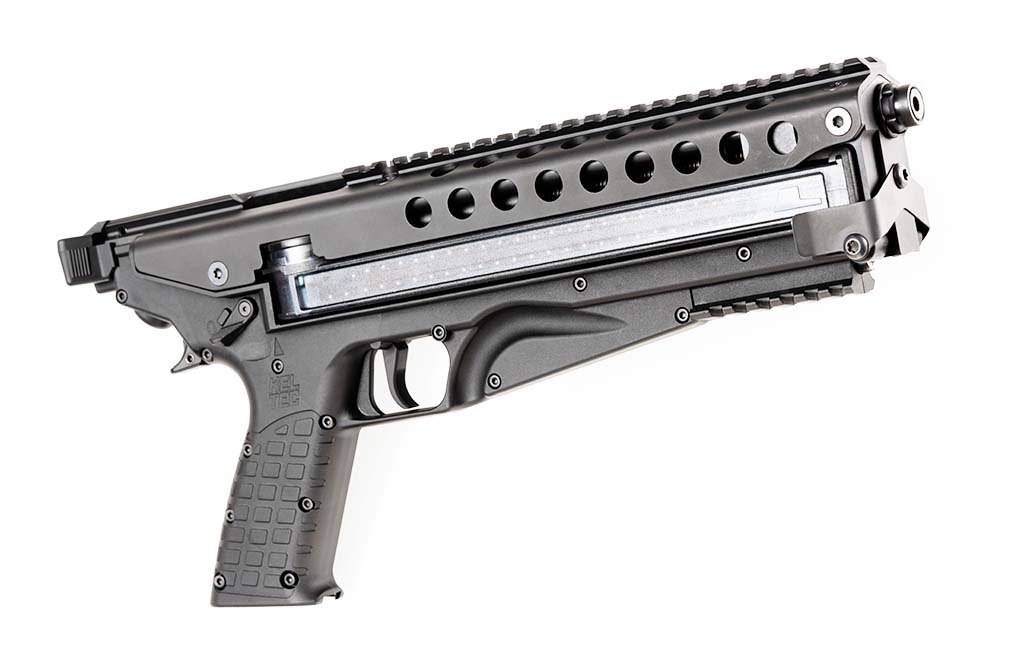
As a pistol, the P50 outclasses all competitors with its 50-shot capacity provided by the use of P90 magazines. With its fixed 9.6-inch barrel, it also outclasses most match pistols on accuracy: fired with just a red dot sight at 50 yards, it easily and consistently overlapped hits on steel. Although chambered in the relatively energetic 5.7x28mm, P50 recoils like a .22 rimfire pistol. I have one load for testing, Federal American Eagle 40-grain FMJ, and it yielded around 1,920 feet per second (fps). Slightly hotter FN ammunition of the same bullet weight would gain 30 to 50 fps.
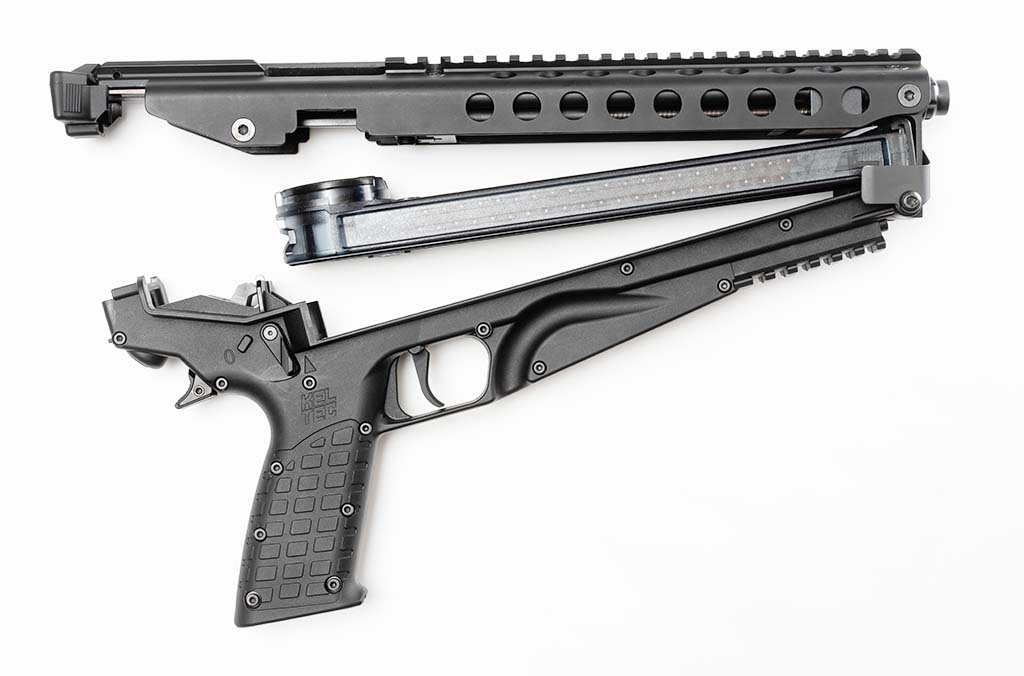
The P50’s action is a plan blowback with dual recoil springs overhanging the barrel. The manual of arms is somewhat unusual: to reload, run the charging handle to cock the hammer, press the action release lever located above the web of the strong hand to pop over the ventilated steel top cover, which is the actual receiver. With the cover raised, pull out the empty magazine, place a full one in its place with the ammunition facing up—not down like on the P90—and close the cover. Run the AR-15-style charging handle once to chamber the first round. While the action can be opened with the hammer down, it should not be closed that way. Since there’s no last shot hold-open, it’s likely that the last trigger pull would drop the hammer. Running the charging handle also ensures that there’s no misfired cartridge remaining in the chamber. The reloading procedure is a bit odd, a legacy of the original design placing a premium on highly dust-sealed internals. However, it only has to be done one-third as often as with a typical service pistol, so there’s no time lost overall. The pistol ships with two 50-round magazines, enough to cover any statistically probable defensive event.


The P50 is quite light for its size at 3.2 pounds and quite compact for the barrel length—15 inches overall. It comes with post and notch iron sights recessed within the Picatinny rail. Thirteen inches of sight radius with elevation adjustment on the front and windage adjustment on the back add up to considerable precision: standing, I could consistently hit a silhouette target out to 35 yards. At 50 yards, hit probability with factory-adjusted iron sights dropped to 50%. With a red dot, however, I had a group less than an inch from the same distance. While my test firing was done with the extra-sharp and clear Vortex UH-, a lower sight would work better by reducing the reticle height over bore. With the barrel placed fairly high over the pistol grip, low-profile optics reduce the possibility of tilt affecting windage. Despite the relatively high boreline, the muzzle flip is negligible. Recoil is remarkably slight for a blowback pistol firing a high-velocity cartridge. This is achieved through long bolt travel, more than double the cartridge length, and through the use of a polymer recoil absorber wrapped around each return spring. The long top rail and the shorter dust cover rail allow for lights, lasers and other accessories.
For firing standing, the included two-point sling steadies the pistol very well. One end of it fits the QD receptacle on the bottom of the pistol grip, the other on the back of the lower. The pistol can be carried on the strong side or across the body and pushed out against sling tension for improved control. There’s no perceptible shift in balance as the ammunition in the magazine is depleted. P50 may be held with the support hand in front of the strong hand, or with the conventional thumb-over-thumb hold. I have shot it one-handed with similar accuracy but with slower return from a slight sideways twist upon firing.
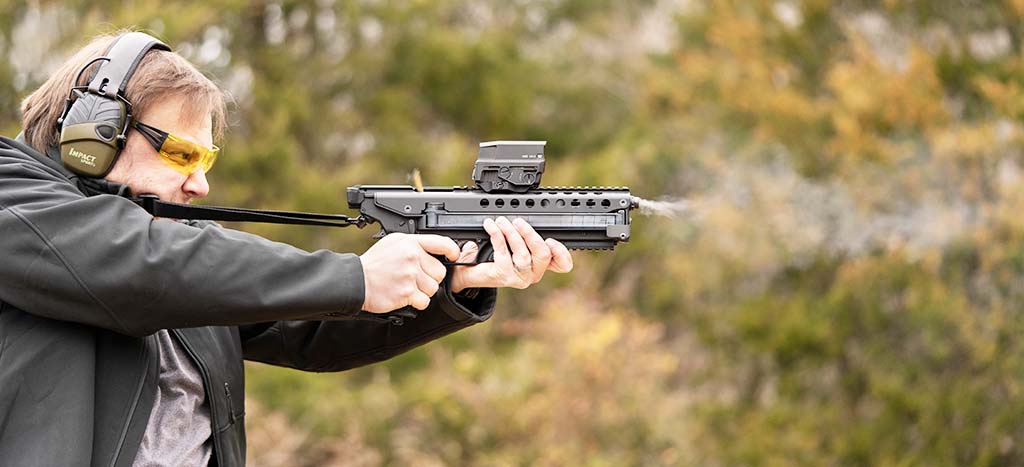
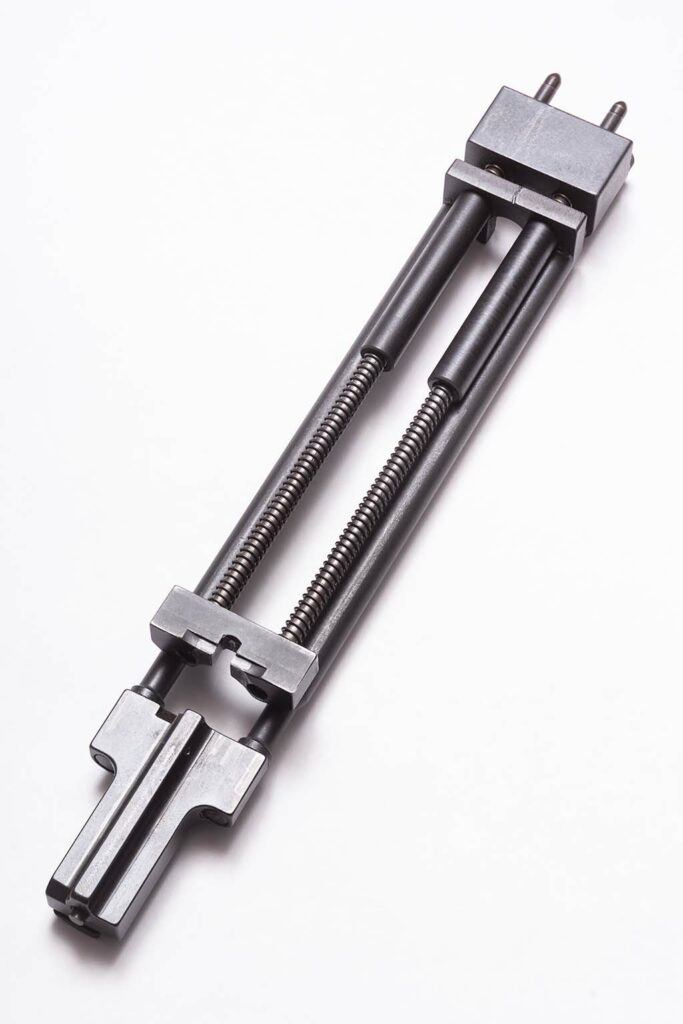
The ambidextrous safety lever blocks the sear and disengages the trigger, resulting in a floppy trigger. With the trigger pull itself being long but light—5 pounds with a wide trigger face—this gives minimal feedback with gloves on. The geometry of the trigger pull favors a two-handed hold to avoid dipping the muzzle at the end of the arc. The reset is nearly at the start of the travel, with a feeling of very light double action. With dispersion at 50 yards not exceeding an inch and a 5.7×28 trajectory being very flat, it’s reasonable to expect effective hits past 150 yards, with the residual velocity still over 1,350 fps. Hit probability is much higher than could be expected with a conventional pistol. Terminal performance is moderate but has the advantage over slower calibers in being able to defeat soft-body armor. High-velocity frangible loads in the 29- to 32-grain range also offer the advantage of rapid fragmentation upon impact, reducing over-penetration and ricochet hazard.
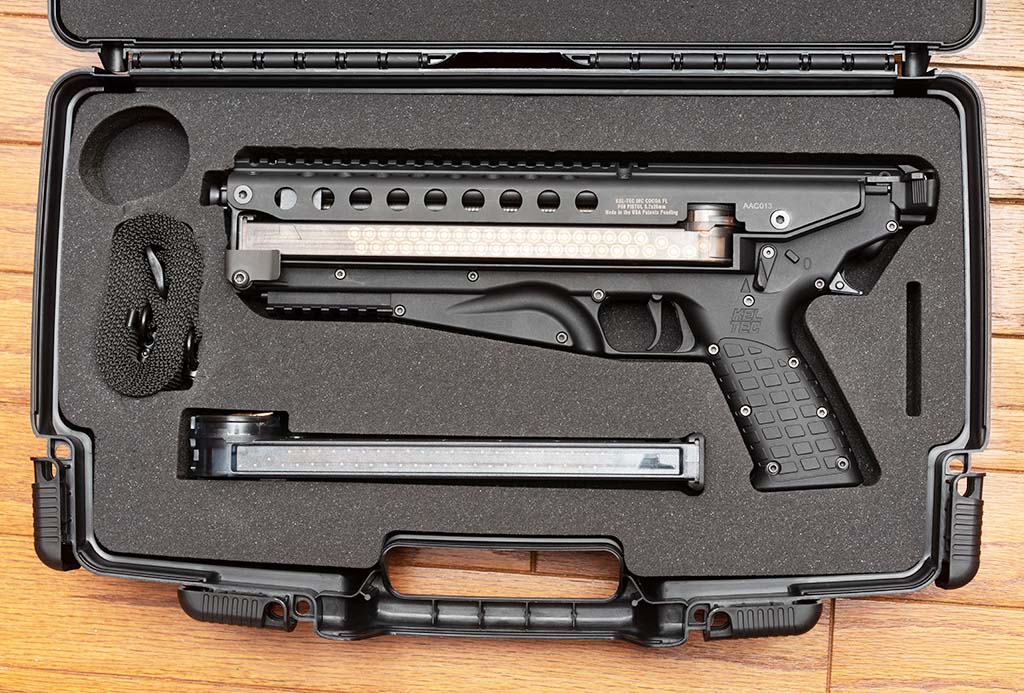
Disassembly is extremely simple. With a cartridge or just fingers, pull the recoil block forward and away from the receiver. It comes out as a single unit. After that, the charging handle comes out of the back, and the field-stripping is complete, with full access to the chamber. Reassembly is in reverse order, taking only a few seconds. Ejection is up and to the front right, posing no hazard to left-handed shooters. The barrel length is sufficient for most of the 5.7×28 ballistic potential. Muzzle flash is transient and small, at about 4 inches long and 1.5 inches high, and doesn’t intrude into the sight picture much. The barrel is threaded 1/2×28 for a flash hider or sound suppressor, and the muzzle ships with a knurled thread protector. While a sound suppressor won’t affect the bullet flight noise, the crack from the small projectile isn’t as injurious to the shooter’s ear outside as the otherwise loud report. Most of the steel .22 suppressors are rated for 5.7x28mm.
Good Buy
In sum, Kel-Tec’s P50 has a lot of defensive capability in a compact and lightweight package. It is significantly more accurate than machine pistols like the Steyr TMP or IWI Uzi®, it carries more ammunition and reaches further distances. I expect it will become popular at ranges and on Hollywood sci-fi sets alike.
| This article first appeared in Small Arms Review V25N3 (March 2021) |



